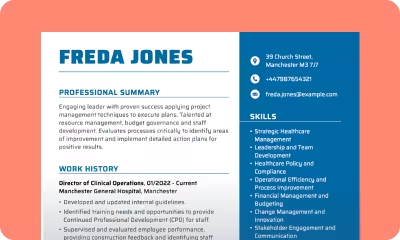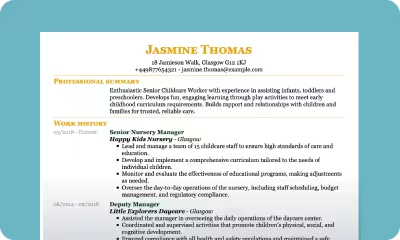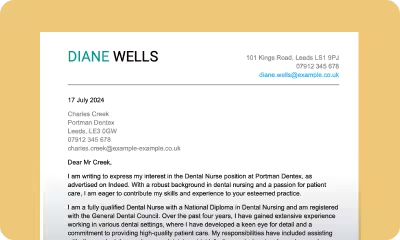How to start a CV
Struggling to start your CV? Don’t worry, you’ve come to the right place. With our expert tips and guidance, you’ll create a compelling CV that makes a strong first impression on recruiters.

Our customers have been hired by: *Foot Note
You have browsed the job forums, found a perfect position that matches your expertise, and researched the company – now what? If the role ticks all your boxes, the next step is to start writing a CV that will blow the competition out of the water. How hard can it be?
While it sounds easy on paper, many people struggle to begin. There are thousands of online resources offering conflicting advice – not to mention hundreds of layouts claiming to present your top talents in the best possible light. Understandably, this wealth of information is counterproductive and prevents candidates from putting pen to paper.
We are the experts at cutting through the noise, and the following guide will help you overcome writer’s block. We will explain how to start a CV without getting overwhelmed, what introductory sections to include, and general advice for CV writing.
Why you need a CV
Before we reveal how to approach your starter CV, it's helpful to understand why you need one – having a purpose makes the writing process much easier. Almost every job requires a compelling curriculum vitae, often alongside a customised cover letter.
Catches the employer's attention
First impressions matter, so you must learn how to start a CV correctly. The most important information, such as your personal statement, should come towards the top of the page. Here, you'll explain why you're the best candidate for the job in three to four punchy sentences (more on how to start a CV personal statement later). Ultimately, the initial sections should ignite the reader's interest and encourage them to learn more.
Streamlines the recruitment process
Employers and recruiters can't stand messy, muddled-up CVs. However, considered applications streamline the recruitment process, earning you some much-needed brownie points. Choosing a logical and professional CV format comes before anything else. Luckily, there are options for every industry and experience level.
Highlights your value
Above all else, a well-written CV positions you as an expert in your field. Combined, the personal statement, work experience section, and list of qualifications spotlight your unique attributes and tangible skills. The more the employer learns, the better – they'll use this information to decide whether you deserve a coveted interview spot.
How to start a CV in three simple steps

Wondering how to start a CV? There's more to it than choosing a layout, adding your contact details, and crafting a powerful personal statement. Instead, the process begins with tonnes of research. Preparation is the key to success. Plus, it’ll help you avoid that sinking feeling when you don’t know where to start. Before tackling the introductory CV sections, we suggest implementing the following advice.
STEP 1
Read and re-read the job description
You'd be surprised how many candidates send cookie-cutter CVs that don't reflect the job description, partly because they don't understand the importance of customisation and partly because of laziness. However, this is a grave mistake. Employers receive hundreds – if not thousands – of applications and won't waste time on starter CVs that miss the brief.
The job advertisement is basically a company's wish list, so study it closely. Reading and re-reading the specification is vital – paired with taking plenty of notes. List the skills, experience, and qualifications the employer wants, and match yours as closely as possible. As every job is different, you'll need to make minor adjustments along the way.
Another top tip is to avoid copying the job description word for word. While you can use it as a reference, employers prefer applicants who can think for themselves.
STEP 2
Find an easy-to-use online builder
Using an online builder removes the stress from CV writing. When you don't have to worry about the format and what sections to include, you have more headspace to focus on the all-important content.
The best online builders use drag-and-drop functionality to make organisation a breeze. Plus, they offer step-by-step guidance on completing each section. There are two options to consider – create a CV from scratch or choose a new template and import existing information.
STEP 3
Draw inspiration from expert CV examples
Like the online builder, expert CV examples can help you overcome mental blocks and procrastination. Simply browse our library of industry-specific CVs and find the correlating job title. Once you've done this, you'll be able to see what kind of things to include and how to talk about them – usually in plain English and bolstered by facts.
CV examples are also handy if you have a sparse employment history because they show you how to maximise your top qualities. The following sections will cover the best CV format for your experience, skills, and qualifications.
How to start a CV - examples
Start your CV with the right CV format
Who knew learning how to start a CV had so many steps? We’re nearly ready to run through the first few sections. However, we can’t continue without mentioning CV formats. Choosing the correct template can make or break your application – some are more suitable for experienced candidates, while others are better for school leavers or industry hoppers.
There are two popular CV formats in the UK – the reverse-chronological CV and the skills-based CV. Both organise your information so it’s easy to consume, using clear headings, sections and bullet point lists. However, they focus on very different things.
Reverse-chronological CV
Without a doubt, the reverse-chronological CV is the most popular option for job-seekers because there’s plenty of space to deep dive into your employment background. By outlining previous positions, you can demonstrate how you put your technical and transferable skills into practice, industry-specific knowledge, and any notable achievements.
As the name suggests, the reverse-chronological structure runs through your past careers, starting from your current or most recent role. Your contact details and personal statement usually come first. The CV skills, education, interests, and references sections follow.
Include the job’s details, three to six responsibilities, and a few show-stopping statistics to dazzle employers. Each role might look a little something like this:
Midwife | Liverpool Health Hospital | June 2019 – April 2023
- Provided exceptional care in a busy maternity ward
- Trained and offered support to over 150 junior midwives
- Assisted senior midwives and doctors
- Created a new infant care education pamphlet with a 98% positive feedback rate
Skills-based CV
In contrast, the skills-based CV (also known as the functional CV) focuses on your transferable skills. It’s less specific than the reverse-chronological structure, and sells your potential rather than your technical experience.
As for the layout, the CV skills section replaces your employment background. Like before, your contact details and personal statement come first, whereas the education, interests, and references sections follow.
Here, focus on umbrella skills and list tasks you can perform underneath each. For instance:
Administration
- Confident using Microsoft Office programmes
- Experienced in accounting software, such as QuickBooks
- Organised a busy personal schedule at college
- Successfully worked to strict deadlines
How to start a CV with no experience?
One of the questions we get asked time and time again is how to start a CV with no experience. Firstly, you might need to give yourself more credit – even if you’ve never had a traditional job, you can talk about volunteering, temporary contracts, summer positions, and more. Include these in the reverse-chronological format.
If you’re really struggling – for example, you’ve been out of work for a long time or recently left full-time education – use a skills-based CV to draw attention away from gaps in your employment history. Some candidates also use their cover letters to provide more context.
Format aside, always begin your CV with your contact details and personal statement. Otherwise, you’re unlikely to make a splash in the sea of equally brilliant candidates.
Adding your most up to date contact details
Sometimes, the little things matter most, like adding your most up-to-date contact details at the top of the page. How else will employers get in touch if they want to offer you an interview? You should outline:
- Full name – first name and surname
- Location – including postcode
- Phone number – the best one to reach you on
- Email address – something professional and work-appropriate
- Relevant social media profiles, such as LinkedIn
It sounds straightforward, but many applicants skip to the personal statement and then wonder why they don’t receive responses. On top of this, knowing what not to include is just as helpful. There’s no need for an employer to ask about protected information, including:
- Age or date of birth
- Marital status
- Nationality
- Sexual orientation
In rare cases, it might be appropriate to include a photo – modelling and acting spring to mind. However, you don’t need headshots for data-entry, no matter how fabulous they are!
How to start a CV personal statement
Wondering how to start a personal statement on your CV? You’re in the right place. This short, attention-grabbing paragraph is arguably the most important introductory section because it presents a well-rounded view of your capabilities. If it’s not punchy and impactful, the hiring manager will quickly move on to the next candidate.
Why is the personal statement a big deal?
The personal statement offers a fascinating insight into your strengths, achievements, and skills. It’s the first glimpse the reader gets of you as a professional, therefore an invaluable recruitment tool. Best of all, it’s concise – busy employers don’t have the time to sift through pages of text, so they rely on the personal statement for an overview of your abilities.
How to format your personal statement
Summarising your professional history in three to four short sentences – or 50 to 100 words – is challenging but not impossible. We’ve devised a handy formula to get you started and ensure you cover the most relevant information.
We suggest breaking your personal statement down into three sections:
- Who you are
- What you can achieve
- How you can achieve it
Sentence one should include your years of experience and career focus. Sentence two focuses on tangible results that you have accomplished or can accomplish. Finally, sentences three and four describe the unique skills and areas of expertise that will help you flourish in your new role. It’s really as simple as that!
The final text should look something like this:
A talented and goal-oriented sales manager with over five years of experience in the computer software industry. Achieved record-breaking sales, consistently reaching 180% of monthly targets, and won the prestigious Salesperson of the Year award for three years running. Able to sell the latest computer software to financial institutions and resolve complex user problems. Confident in training new staff members and devising innovative development programmes.
Five tips for a persuasive personal statement
Like learning how to start a CV, there’s an art to personal statement writing and a few things to remember as you transfer your ideas to paper. Follow the guidance below for maximum impact, and take as many breaks as you need. A short walk, brain-boosting shower, or quick catch-up with friends can get the creative juices flowing when you’re in a funk.
Write in the third person
There’s nothing more off-putting than “me, myself, and I”. Not only does it sound repetitive, but it puts too much emphasis on you rather than on what you can do for a company. Here’s what you want to avoid:
I’m a passionate sales manager who loves working in the computer software industry. I consistently hit my sales targets, and I’ve won the Salesperson of the Year award for three years running. I can sell the latest computer software to financial institutions, and I like to resolve complex user problems.
Instead, using the third person eliminates waffle, clarifies your message, and sounds more professional. Our favourite ways to open sentences without using the first person include:
- Confident / skilled / experienced / proficient in
- Capable of
- Able / driven to
- Adept at
- Comfortable with
Mention facts and figures
Some personal statements are full of hot air, including lofty claims without any evidence to back them up. If you don’t substantiate your skills with facts and figures, you’re simply asking the employer to believe you – and why would they do that? The most successful candidates walk their talk and prove their capabilities with tangible results.
There are several ways you can introduce statistics into your personal statement. Ideally, you should focus on a percentage or profit outcome, being as specific as possible, such as:
Boosted productivity by 78%
Saved the company £348,000 in six months
However, numbers can vary from day to day, so some people prefer to use averages or a broader range. Plus, percentages and profits aren’t always applicable. In these cases, you could discuss how many people you’ve managed or facilities you’ve run.
Trained 80 – 100 employees each month
Supervised 10+ wards of over 100 patients.
Quantifying your experience with numbers is only ever a positive – do it wherever you can.
Keep the tone confident
We know talking about yourself can feel awkward, but now’s not the time to downplay your abilities. Decision-makers flock to confident candidates who can articulate their experience and skills – in the job-hunting world, there’s no such thing as too much self-promotion!
But how do you sound confident if you’re naturally introverted or a little nervous? Our top tip is to include bundles of positive adjectives and rousing action verbs to keep the reader wanting more.
Positive adjectives reveal more of your personality, which is equally important as your technical know-how. Swap overused words for creative alternatives, such as:
- Friendly – pleasant, amicable, or thoughtful
- Intelligent – imaginative, articulate or innovative
- Honest – trustworthy, diligent, or reliable
- Sociable – engaging, charming, or supportive
As for action verbs, they replace tired phrases like “responsible for”. Popular options include:
- Championed
- Spearheaded
- Developed
- Negotiated
- Improved
Avoid embellishment or exaggeration
While it’s tempting to sneak in a few fibs to make yourself sound more impressive, employers can usually sniff out embellishment and exaggeration. Even the tiniest lies will catch you out during the interview stage – you’ll be asked questions you’re not qualified to answer.
Although copying other people’s work might feel easier, being as authentic as possible is the real secret to success. Stuck for ideas? Ask friends, family, or colleagues how they would describe you, and use this feedback to guide your statement.
Stick to the most relevant information
One of the biggest mistakes people make when tackling how to start a CV personal statement is centring irrelevant information. While you are talking about yourself, it’s not the right place to discuss career ambitions, gaps in your employment history, or notice periods. Save this kind of information for your cover letter.
General advice for CV writing
Now you know the ins and outs of how to start a CV, let’s explore some general CV writing advice. The following tips should always be on your radar so you don’t veer off track and make costly errors.
Follow professional formatting advice
Before you start your CV, it’s helpful to know key formatting advice. We’ve already covered the best layouts to wow the trickiest hiring managers, but here are some more pointers:
- Keep your CV one to two pages long maximum
- Break up large chunks of text with headings and bullet points
- Use sections to improve your writing’s flow
- Send your CV as a Word or PDF file unless asked otherwise
- Avoid colours, images, or other visual distractions
Additionally, type in a professional and legible font. The most common option is “Times New Roman” but you could also use “Calibri”, “Arial”, or “Helvetica”. We suggest sticking to 12pt text, although you might get away with 10pt if you have a lengthy CV. Plus, use bolding, italics, and capitalisation to emphasise information – just keep it consistent.
Progress trumps perfection
Whether you’re crafting a CV, sending a letter, or writing a novel, progress trumps perfection every time. The hardest part is just getting started, especially when your dreams are at stake. But it’s better to get something down than nothing at all – you can always make revisions once you’ve completed the bulk of the work.
Ask for feedback along the way
Lastly, don’t be afraid to ask for feedback – a fresh pair of eyes can pick out sneaky mistakes and repetitiveness. Online spell-checkers are equally valuable tools and completely free, so it’s a good idea to take advantage of them before finalising your application.
Takeaways for how to start a CV
If you’ve been scratching your head and putting off your job application, hopefully you feel more confident after reading this guide and learning how to start a CV. It doesn’t have to be a chore. All you need to do is research CV writing using online tools, choose the correct format for your experience level, and nail the introductory contact details and personal statement. What’s more, keep referring back to the general advice whenever you feel stuck.
If you need more inspiration about how to end a CV or other CV sections, such as work experience, you can find lots more guidance on our website. Or get started straight away with our online CV builder.

Jagoda Jaskowicz
Senior Content Editor, Translator
*The names and logos of the companies referred to above are all trademarks of their respective holders. Unless specifically stated otherwise, such references are not intended to imply any affiliation or association with myperfectCV.










